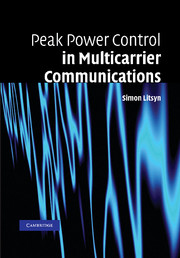Book contents
- Frontmatter
- Contents
- List of figures
- List of abbreviations
- List of notation
- 1 Introduction
- 2 Multicarrier signals
- 3 Basic tools and algorithms
- 4 Discrete and continuous maxima in MC signals
- 5 Statistical distribution of peak power in MC signals
- 6 Coded MC signals
- 7 MC signals with constant PMEPR
- 8 Methods to decrease peak power in MC systems
- Bibliography
- Index
4 - Discrete and continuous maxima in MC signals
Published online by Cambridge University Press: 03 December 2009
- Frontmatter
- Contents
- List of figures
- List of abbreviations
- List of notation
- 1 Introduction
- 2 Multicarrier signals
- 3 Basic tools and algorithms
- 4 Discrete and continuous maxima in MC signals
- 5 Statistical distribution of peak power in MC signals
- 6 Coded MC signals
- 7 MC signals with constant PMEPR
- 8 Methods to decrease peak power in MC systems
- Bibliography
- Index
Summary
In many situations it is beneficial to deal with a discrete-time “sampled” version of multicarrier signals. This reduction allows passing from the continuous setting to an easier-to-handle discrete one. However, we have to estimate the inaccuracies stemming from the approach. In this chapter, I analyze the ratio between the maximum of the absolute value of a continuous MC signal and the maximum over a set of the signal's samples. We start with considering the ratio when the signal is sampled at the Nyquist frequency, i.e. the number of sampling points equals the number of tones. In this case I show that the maximum of the ratio over all MC signals grows with the number of subcarriers (Theorem 4.2). However, if one computes a weighted sum of the maximum of the signal's samples and the maximum of the signal derivative's samples the ratio already is, at most, a constant (Theorem 4.5). I further show that actually the ratio depends on the maximum of the signal; the larger the maximum is the smaller is the ratio (Theorem 4.6). An even better strategy is to use over sampling. Then the ratio becomes constant tending to 1 when the over sampling rate grows (Theorems 4.8, 4.9, 4.10, and 4.11). Furthermore, I tackle the case when we have to use the maximum estimation, projections on specially chosen measuring axes instead of the absolute values of the signal (Theorem 4.14). Finally, I address the problem of relation between the PAPR and the PMEPR and show that the PMEPR estimates the PAPR quite accurately for large values of the carrier frequency (Theorem 4.19).
- Type
- Chapter
- Information
- Peak Power Control in Multicarrier Communications , pp. 68 - 103Publisher: Cambridge University PressPrint publication year: 2007



